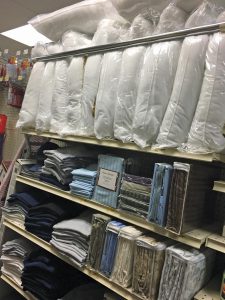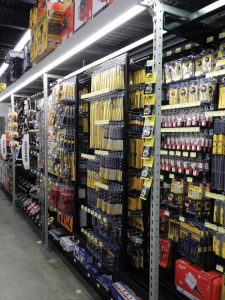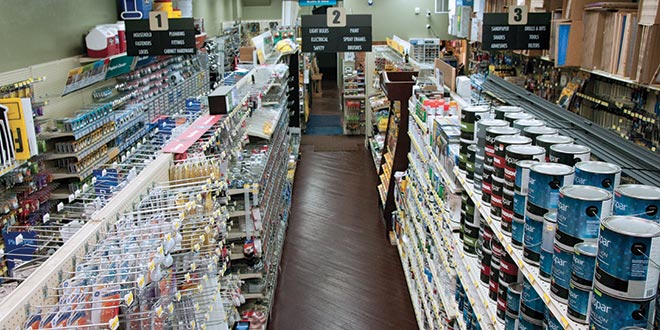By Jesse Carleton, jcarleton@nrha.org, and Liz Lichtenberger, llichtenberger@nrha.org
To view a PDF of this story, click here.
To some, 1,500, 2,500 or even 5,000 square feet may seem like an impossibly limited amount of space to sell eight core hardlines categories, plus a niche or two. However, Matt Woods, COO of Acme Lock & Hardware, a hardware store and locksmith in downtown Cincinnati, does it every day. And he’s not alone, either.
While the average size for a typical independent hardware store’s salesfloor may be around 9,500 square feet, there are thousands of retailers who have much less space than that at their disposal. They’re not letting that size stop them from making a big impact on their markets, and they have lessons to teach retailers of any size about efficient merchandising, tight inventory control and strong product selection.
In fact, small stores can be highly profitable. A smaller building means lower overhead costs and allows retailers to quickly move inventory in and out of the store. It also ensures retailers keep their displays fresh and continually try new merchandising tactics.
To find out more about what makes these retailers with small businesses so successful, Hardware Retailing turned to Woods, as well as two other retailers who operate profitable operations within the confines of 5,000 square feet, or less, of retail space. Read on to learn how they’ve built successful businesses in small spaces. And click here to learn how a fourth store successfully merchandises its 2,800-square-foot salesfloor, which include bulky products such as sleds and cold-weather clothing.
At the City’s Center
Acme Lock & Hardware
Cincinnati, Ohio
Retail space: 1,500 square feet
Acme Lock & Hardware, in downtown Cincinnati, Ohio, may have only 1,500 square feet of retail space, but it’s more—much more—than what the store used to have.
“For 75 years, we had a 500-square-foot store around the corner from our existing location,” Woods says. “About 10 years ago, after several stores in the downtown area had closed, my parents purchased the store next door so we could add hardware to our offerings. Our store is like the Walgreens of hardware—it’s a convenience hardware store.”
In addition to the salesfloor, there’s an additional 1,000 square feet for storage.
One reason for the small store is the cost of real estate in downtown Cincinnati. And, Woods says the family didn’t want to build too big when they moved to the new building in 2006. “We let the market dictate,” he says.
 Keeping an Eye on Inventory
Keeping an Eye on Inventory
The biggest part of using a small space wisely is having the right product mix.
Woods stocks primarily A and B movers and consistently asks customers for feedback about what items they’d like to see in the store.
“We think 80 percent of our profits come from about 20 percent of our customers, so we use that 20 percent to identify what we need,” he says. “We know our products will turn faster, because that’s what our customers want.”
His weekly orders and deliveries also help him determine what those products are.
“The worst feeling in the world is when you have to tell someone you don’t have what they are looking for,” Woods says.
Once or twice a month, he and his staff go through the store to identify dead items. There isn’t room to keep those products, even for clearance sales, so Woods donates the unsold product to a local reuse center and ministry.
It may sound counterintuitive to keep trying new products when you have so little space to work with, but Woods says he loves to try new things. “My dad hates that we spent money on that inventory and it’s not selling, but I love seeing what can go in its place.”
It doesn’t take him long to find a replacement product—he usually has a list of customer-requested products and can try one or two of those once he’s rid the store of the dead inventory.
“We have several maintenance guys who are regular customers, and they’ve even helped us lay out what products should go where,” he says. “If I have a couple of sections that haven’t been turning, they are more than happy to give us some ideas of what might make better day-to-day movers.”
Average inventory turns at Acme are 2.3, Wood says, compared to 1.8 for a typical hardware store, and 2.4 for a high-profit hardware store (according to NRHA’s 2016 Cost of Doing Business Study), and his sales per square foot is $247, compared to $176 for a typical hardware store and $214 for a high-profit store. With just a quick look at these numbers, it’s easy to see Woods is doing something right.
Creating the Right Look
“I see our store like a giant puzzle,” Woods says. It’s a puzzle he spends plenty of time on, as he shifts the product mix to make it fit in a tight space.
He’s learned a few tricks to do more with less; and he’s now able to make 12-foot planograms fit into 8-foot sections. “I’ll use every square inch available. It seems like some manufacturers try to be very liberal with the amount of square footage they want, so we try to create as much square footage as we can.”
Some planograms may require a couple of inches between peg hooks. Woods skips that step. He also keeps everything as linear as possible, so products flow logically from one department to another throughout the store. Because of a small amount of space, it’s more difficult to create clear definitions between departments—a few aisles for electrical, a few more for plumbing. Instead, he relies on signage to help customers easily find what they need.
“I love vendor POP,” he says. “I try to use their type of marketing to set each aisle or each assortment, and I use aisle violators as well. I try to have a logical flow throughout the store—in the electrical section, we’ll go from electrical supplies to home safety to batteries. We want people to be able to find things easily, without it being too busy inside the store.”
 The Good and the Bad
The Good and the Bad
One challenge of a small store, Woods says, is that he doesn’t always get the same level of attention from his vendors that a larger store with more volume might. While he often orders full planograms, sometimes he simply doesn’t have the space for them and has to place smaller orders instead.
But there are advantages to having a smaller store, too. “Our customers are able to find products and receive excellent customer service quickly—they can be in and out of the store in a matter of minutes,” he says. “That’s important when customers know what they need and want to buy it quickly and easily.”
And everything is within easy reach. “When you walk in the door, you are just a few steps away from 95 percent of our product.”
While Woods has found plenty of ways to successfully have a profitable business in a small space, he’s also found the opportunity to expand his salesfloor. The business’ downtown Cincinnati location will soon move to a new building, allowing Woods to expand his showroom to 8,000 square feet. This will offer him the opportunity to take what he’s learned about merchandising and inventory control and use those lessons in a larger space.
“We feel the demand for urbanization is going to continue,” he says. “If we don’t make the investment now, it could be too costly in the future, or we could have a competitors step in. We are the only hardware within a couple of miles right now, and when you’re downtown, a couple of miles is a long distance.”
An Island Dream
Chet’s Hardware
Avalon, California
Retail space: 3,500 square feet
Chet’s Hardware is what many home improvement retailers would like to be—the only retailer in town. But for owners Mike and Cinde Cassidy, that town is only about 2 miles square and sits on a small island 26 miles off the coast of Los Angeles. Space in the small town of Avalon is at a premium, and limited retail space is something the couple must address every day. While they have a prime location, nestled in a shopping mall on a busy street, Chet’s Hardware only has 3,500 square feet of salesfloor with a small backroom.
They’ve managed the limited space masterfully. They serve the island’s residents as well as the thousands more that visit the island during peak tourist season. They also sell more than just hardware. Housewares is their second largest department. For customers looking to purchase a major appliance, it’s the only place in town to get one right away. Paint is the couple’s No. 1 seller. They go deep in key categories such as plumbing and electrical with several hard-to-find items, and they have created a business with several commercial customers. How do they do it in a small footprint? It involves nimble merchandising and careful ordering.
 Find Merchandising Resources
Find Merchandising Resources
Without a lot of space for merchandising, Cinde uses her creativity and ideas she gathers from being out in the industry. She starts with the resources available through her co-op. “A couple of years ago, our co-op sent a team to remerchandise the store. They helped us see how we could put as much product in about two-thirds of the space we had before,” she says.
The couple also attends the National Hardware Show® and visits other retailers. They usually bring back ideas to implement in their store.
“A general rule we try to follow is, less pegboard is better. After all, we’re selling products, not pegboard,” Cinde says. “We try to get items close together, and usually with just one facing, so you don’t see a lot of the fixture. We also use the knowledge of our vendor sales reps. They specialize in knowing how to use space and how to make their product look good.”
Sales Out the Back Door
Some of the products the Cassidys sell never touch the salesfloor. Bulk orders of paper products or cleaning supplies they sell to other businesses in town can go straight to the customer shortly after they unload it from the delivery truck. Commercial sales, says Cinde, are their next growth opportunity, since they can increase sales without increasing their volume of inventory.
Their strategy is similar to the one they use for large appliance sales. Instead of giving up valuable floor space to multiple models of appliances, Mike has one display model with a couple of different sizes in the backroom for those who need a new appliance right away. Most customers are willing to wait until the order comes in, especially since they may want to order a specific model. “We take them straight from the loading dock to the customer’s house, so it never hits the floor of the store and never takes up space,” he says.
Establish a Pre-Order Habit
Rotating seasonal items is standard practice for many retailers, but the Cassidys need to put a short turnaround time on that merchandise. Rather than bringing in seasonal merchandise far ahead of the season and then trying to attract customers’ attention to the items over the period of several weeks or months, Cinde says their approach is different. They have a small amount of space they can dedicate to seasonal items, so they discuss with their customers what seasonal products they might need, and then order appropriately. Letting customers pre-order seasonal products allows the Cassidys to fill the needs of the majority of their customers and save merchandising space on the salesfloor, since most of those pre-ordered items never hit the salesfloor.
“We have a long-term relationship with our customers and have trained them to know that we’ll have certain products at a certain time of the year,” she says. “We can work with our customers to order just what they know they will need. That gives us a shorter turnaround on inventory, so we can have room for other products our customers need.”
 Go Deep When Necessary
Go Deep When Necessary
Despite the size of the store, Chet’s Hardware stocks 10 different types of coffee pots. It’s one of the Cassidys’ best-selling items, in a category that is a destination for many customers. Just because a store is small doesn’t mean it shouldn’t stock plenty of product in key categories.
“Being the only hardware store on the island means we need to go deep in some areas, such as fasteners and plumbing. If you have that one hard-to-find part the customer needs, they will come in and buy other stuff,” says Mike.
That doesn’t mean he does it in all categories. The lawn and garden offering is very limited, due to a very small demand on the island. He also has a difficult time competing on power tools, since the higher freight charges he has to pay to get anything shipped to the island make it difficult to compete on those types of higher-priced items.
One challenge any retailer faces is where to offer a larger array of products, and what categories don’t require as many items. But in a smaller store, perhaps, there is less room for error.
Doing More With Less
Fuller and Son Hardware
Little Rock, Arkansas
Retail space: 4,300 square feet
When Bobby Fuller decided to open a store in a neighborhood called The Heights in Little Rock, Arkansas, he didn’t have much choice in the size of building he would use. Most retail spaces in the historic area were small and landlocked. But what he could choose was how he filled that space. Today, the 4,300-square-foot salesfloor packs as much merchandise as a store three times its size.
Fuller operates six Fuller and Son Hardware stores throughout central Arkansas, ranging in size from 20,000 square feet down to the smallest in The Heights, his newest location. “That store is our third best performing store,” he says. “It probably has 35,000 SKUs, probably more merchandise than the rest of our stores, except for our largest store.”
The ability to stock just about anything, including lumber and bagged goods, in an area with such a limited footprint may seem like magic. For Fuller, it’s all about creative merchandising, constant attention to inventory and meticulous attention to housekeeping—all principles retailers of any size can use to improve their operations.
 Sliders and Drawers
Sliders and Drawers
“We have a lot of customers who visit our other stores who come here expecting to find the same items,” Fuller says. “We intend to have it for them. We utilize every square inch of this store.”
It’s no surprise then that merchandising in The Heights store is anything but typical. Fuller leaned heavily on his distributor for advice on how to put together a merchandise plan that would fill the space and provide everything his customers needed. His customers range from the walk-in DIYer to contractors and commercial accounts. He needs a little bit of everything, and not just the A and B items.
The inventory goes deep into all of the hardlines categories, including a full line of power tools and plumbing fittings. Staff can offer all of the services of a traditional hardware store, too, such as glass and pipe cutting.
To find a place for all of that merchandise, Fuller uses sliding racks three tiers deep. Many of the shelves have drawers, which allow for additional storage. That allows him to stock full assortments as well as a few niche lines, such as pet supplies, that fit with customers in the area.
Even though he has a small space, Fuller resists the temptation to turn his endcaps into just another space for a standard run of merchandise. He uses them for promotional displays and changes them out weekly, staying in line with merchandising best practices.
Help Every Customer
Because the merchandising is so unusual, customers might have to dig a little to find what they want, especially when drawers and sliding racks may hide some of the products. That means staff need to be extra conscious to make sure every customer gets attention.
“If a customer doesn’t see something right away, that doesn’t mean we don’t have it; they just have to learn how to use the slider racks and drawers,” Fuller says.
“It’s important that our employees help every customer,” he says. “It also means employees have to know the location of every product in the store and be able to find it quickly.”
 Order Often, Order Everything
Order Often, Order Everything
Shelving height at the store is a standard 8 feet, but due to the sliding racks, the peg hooks are usually shorter. That makes inventory a challenge. Fuller can keep fewer items at a time, and with no backroom where he can store overstock, he needs frequent deliveries. Where in his other stores Fuller may be able to buy case quantities, at The Heights location, he must buy smaller quantities, and buy them more often.
“I have to order once a week here, and my orders are much larger, because I’m ordering more lines every week than at the other stores. There’s a lot more inventory to put on the shelves each week, too, when the truck comes in,” he says.
Outside the store in a shed, Fuller stocks enough lumber and building materials to build a deck or remodel a room. Typically, he supplies that area twice a week by transferring stock from one of his other stores. He also sells plenty of bagged goods, and it’s not unusual for him to sell a truckload of ready-mix cement products in a week.
Fanatical Housekeeping
Despite being packed with SKUs, the Fuller and Son store in The Heights looks anything but cluttered. Housekeeping is something Fuller and his staff stay on top of daily. He uses tote boxes on top of the gondolas as places for storing overstock, and eliminates cardboard packing boxes, which easily become dented or torn.
The interior of the building has bright lights to balance the black fixtures, which give the store an upscale appearance. He doesn’t allow boxes to sit on the floor, either, but insists all products are on display racks, faced, fronted and full.
The exterior of the store must remain spotless, too, especially given the affluent nature of the neighborhood.
“With a store this size, it has to be neat. Housekeeping is everyone’s job, and it happens daily,” he says. “We don’t leave anything lying on the floor. All pegs and shelves are full and fronted. We sell a lot of bagged goods that we have in front of the store. Everything has to be square and perpendicular, and well swept.”
 Hardware Retailing The Industry's Source for Insights and Information
Hardware Retailing The Industry's Source for Insights and Information








